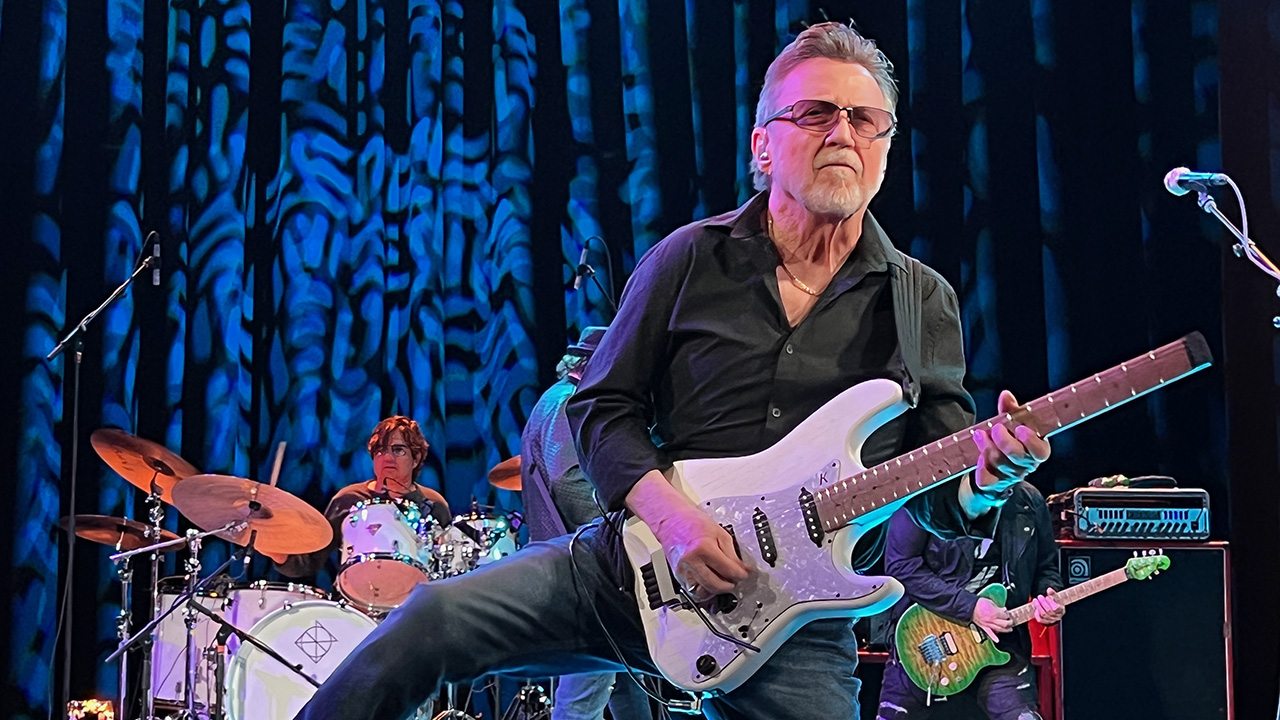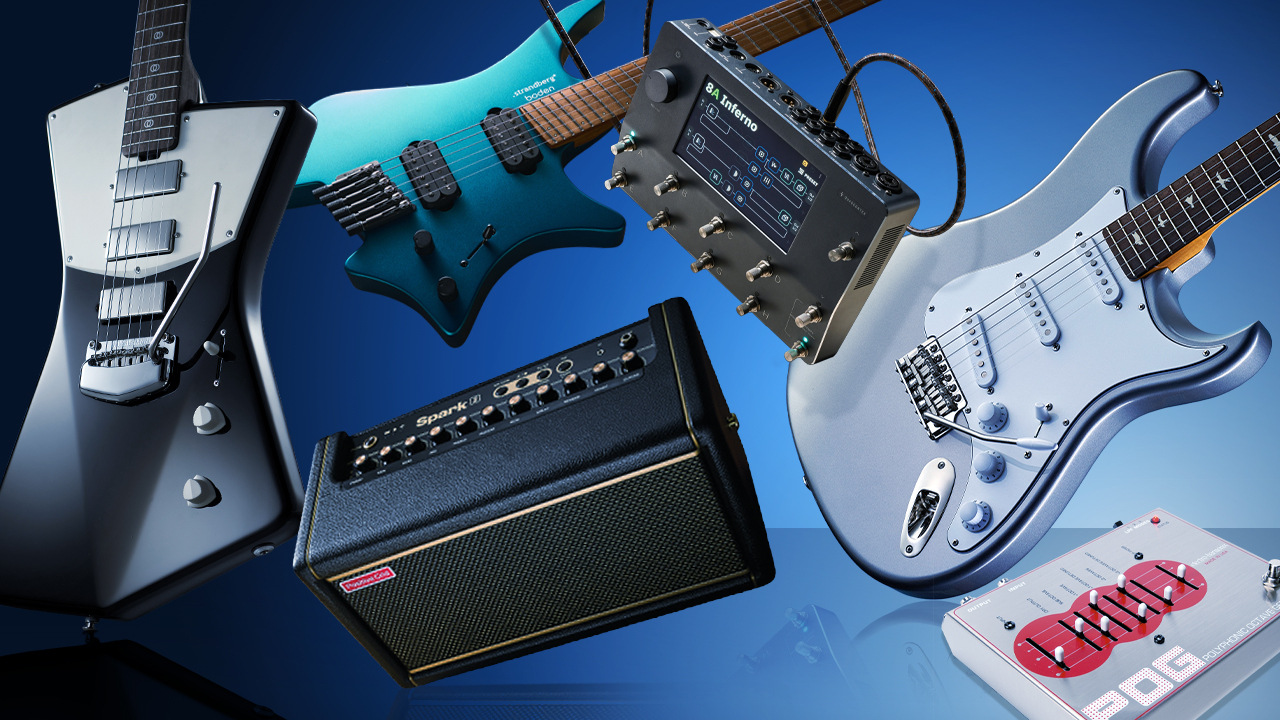“Digital stuff is valid and has a great musical tone… the day to replace tube amps is here”: 50 years on, Buck Dharma is proud of Blue Öyster Cult’s ride, but he isn't afraid to change things up from night to night
Dharma's eclectic guitar work has inspired countless rock and metal players – and he’s comfortable with not being as flashy or fast as he used to be

Be it through the eerie vibe of (Don’t Fear) The Reaper, the chugging proto-metal of Godzilla or the soaring AOR highs of Burnin’ for You, Donald Roeser – aka Buck Dharma – has reveled in eclecticism since the release of Blue Öyster Cult’s self-titled debut in 1972.
As a kid born in Queens, New York, who grew up in Smithtown, Long Island, Dharma couldn’t have dreamed he’d impact rock and metal through his songwriting and hare-brained gear choices. “Oh, absolutely not,” he tells Guitar World. “I thought we were fortunate just to get a record deal. But here I am, doing what I love and making records for the rest of my life.”
It took a while, but eventually, records like Tyranny and Mutation (1973), Spectres (1977), and Cultösaurus Erectus (1980) hit, securing Dharma's status as an icon of early heavy metal badassery. “I feel very fortunate,” he shrugs. “I’ve had a great job all these years. It pays well, and it's fun to do.
“I’ll admit traveling gets harder. I can’t complain, though – I’ve had a dream career. I always advise people to find something they love and do that because you’re going to work hard no matter what you do if you want to succeed. It helps if you don’t hate it.”
Tell me about Blue Öyster Cult's latest live record, 50th Anniversary Live – First Night.
“In October of ’23 we did three nights at Sony Hall in Manhattan. We played for about two hours each night and did our first three LPs in their entirety, which we'd never done before.
“It was great returning to those early records, even though my playing style has changed over the decades. I had to woodshed to play some of those old licks from when I was a kid.”
All the latest guitar news, interviews, lessons, reviews, deals and more, direct to your inbox!
How has your style changed?
“I used to be flashier and play faster. But as I’ve matured, I’ve concentrated more on melody, and applied that to my overall approach. I still rock hard – I’ll never give up rocking – but it’s more of a holistic approach to playing.”
What did your initial vision for the guitars in Blue Öyster Cult look like, and how has that shifted over the years?
“It’s not too different overall, aside from the shift in my approach. We’re still playing the same guitars designed in the ‘50s, and everybody else is too. When you think about the most iconic models of Gibson and Fender, that’s what I think of when I think of this music.”
But you’re also known for using Steinberger guitars.
“I mostly play the Steinberger live. When they came out with those wood-bodied, bolt-on neck guitars back in the day, I liked them, started playing them, and I’ve stuck with them. Of course, I’ve had many guitars – but those seem to suit me best for performances.”
One notable Steinberger of yours is the Cheeseberger. How did you acquire it?
“The Cheeseberger came about when Steinberger was sold to Gibson in 1987, and they moved production from Newburgh, New York, to Nashville, Tennessee. They were going to stop with some of the bodies they had.
“Before they discontinued this one – one of the last off the line – I asked them to make me one with this scalloped body that looked like Swiss cheese. It was a bit of a joke, but it stuck.”
Dating back to the ‘70s you used Gibson SGs and even some semi-hollow guitars.
“When Blue Öyster Cult started playing bigger rooms and arenas, I tried every brand of amp that was popular – Hiwatt, Marshall and even some German stuff. When we recorded (Don’t Fear) The Reaper, I used a Gibson ES-175 that I borrowed from the producer, Murray Krugman.
“But my other lead guitar was a Gibson SG, which was red, and I refinished it in white. It had a Gibson tremolo and, later, a stop tailpiece. That guitar was stolen; years later the Gibson Custom Shop made me a replica, which I don’t like to take out.”
Godzilla is a notable song that you wrote with fierce guitars in it. Do you remember working on it?
“I wrote it in a hotel room in Dallas, Texas, while Blue Öyster Cult was on tour. When we recorded it, I used a Giuliano Balestra Vulcan made by a small boutique luthier in White Plains, New York.
“The body looks like a cross between a Gibson Flying V and a Gibson Firebird. It had horns but they were cut off, so it was very odd-looking – but nice. It also had DiMarzio humbuckers, and it was great. I wish I still had it.”
It would be remiss not to ask about Burnin' for You and the gear you used.
“I used my Les Paul Deluxe, although I was playing a Fender Stratocaster with Bill Lawrence Humbuckers a lot then. And I had one of the early Floyd Rose tremolos – number 25. It had no fine-tuners; you had to get it right the first time and clamp it down.”
By the looks of it, you were tinkering and hot-rodding guitars before it became commonplace in the ‘80s.
“Yeah, I was. I was always anticipating the next big thing. I didn’t foresee that the Strat and the Les Paul would become icons, even though they are now. I always thought something would come along and advance the state of guitar design, which is why I was always attracted to Steinbergers – I liked the composite carbon material for necks and the radius.
“And when it came to pickups, the early pot routes were basically in service of driving the amps harder and getting a little more breakup in there. But it sacrificed the higher output for more mid-range sounds and less high and low-end. So I always preferred the PAF styles over certain types of hot rod pickups.”
You must have been like a kid in a candy shop when gear choices exploded in the ‘80s and beyond.
“It was and is a great time to be alive as a guitarist. The tech of the instruments is one reason – that’s why I started going to NAMM shows back in the day. I just wanted to go because it felt like the world’s largest music store. I loved seeing all the new stuff that wasn’t in stores yet.”
Is there a piece of gear that’s been most important to you over the years outside of your guitars?
“There’s not one iconic thing; I never used pedals back in the day – it was just a guitar into an amp for years. And that has its virtues, because putting a Dunlop Echoplex delay in front of the amp will change how the amp sees the guitar. I got into pedals like distortion and stuff in the late ‘90s or early 2000s.”
What led you to give pedals a go?
“We needed to reduce our stage volume after deafening ourselves for decades. Going into smaller amps and playing smaller venues, I went into the business of using effects. The stage volume can be a fraction of what it was back when it was horrendously loud.”
It shows that a band doesn’t need to be loud to be good.
“Yeah – and the range of overdrive pedals out there now is great. You can get just about any flavor of distortion and sustain you want. My performing rig is almost entirely digital now. It’s cobbled together with a Strymon Iridium Amp & IR Cab; I don't like a lot of the other options out there.
“One of the first things I did was buy a Torpedo [Two Notes Captor] load box and the IR Cab. I flipped out when I saw those years back – I never knew things like that were possible. This was back when modeling devices were coming out, and many things I didn’t think were plausible now were.”
So despite what the old guard says, there is a substitute for tube amps.
“I think there is. The biggest thing you miss with a real amp is the acoustic feedback. If you stand next to a speaker cabinet, you’re gonna feel the effect of how the guitar sounds. You’ll feel the sustained feedback of having a solid body guitar, as a semi-hollow is more of a ringing sustain.
“But the digital stuff is valid and has a great musical tone. So the day to replace tube amps is here. I have Kempers and all sorts of things – I like to mess around with it all. And I find recording with it a huge convenience, since my home studio is so small – I can’t fit huge amps in there anyway.”
I could go a few weeks without playing, but one of the reasons we still perform live is I get a lot of enjoyment out of it
Do you have a favorite Blue Öyster Cult guitar album?
“I’m not an expert on our records. You listen to them so many times when you make them, and then they recede into memory. But working with [producer] Martin Birch was a highlight as a guitarist. The album I’d choose as far as guitars would be Cultösaurus Erectus. It was memorable and had Burnin’ for You, which was great.”
Do you still have the same passion to pick up the guitar daily?
“I could go a few weeks without playing, but one of the reasons we still perform live is I get a lot of enjoyment out of it. I like to entertain myself, and I love to improvise. Some of the arrangements are set in stone, but just about all the solos I do, I improvise every night. So if you see me, you'll probably never hear them the same [twice].”
Blue Öyster Cult wasn’t only influential on hard rock, but also heavy metal. What does the band’s legacy mean to you?
“We’ve always been hard to categorize and peg down. We were all over the place, liked different kinds of music, and had many influences. When we started, Eric Bloom sang most of the songs; but as it turned out, I sang a lot of the chart hits – so there never was a clear idea of what we were.
“We just wanted to make great LPs, and we did that. The worst thing you could say about us was that we were interesting, if nothing else. We weren’t like AC/DC, where you listened to a few songs and knew what to expect. We never wanted to do that. We explored a lot, and I’m very proud of the ride.”
- 50th Anniversary Live – First Night is on sale now.
Andrew Daly is an iced-coffee-addicted, oddball Telecaster-playing, alfredo pasta-loving journalist from Long Island, NY, who, in addition to being a contributing writer for Guitar World, scribes for Bass Player, Guitar Player, Guitarist, and MusicRadar. Andrew has interviewed favorites like Ace Frehley, Johnny Marr, Vito Bratta, Bruce Kulick, Joe Perry, Brad Whitford, Tom Morello, Rich Robinson, and Paul Stanley, while his all-time favorite (rhythm player), Keith Richards, continues to elude him.





![[Don't Fear] The Reaper - YouTube](https://img.youtube.com/vi/gRTpvfItNP4/maxresdefault.jpg)

